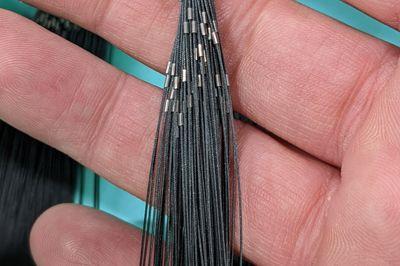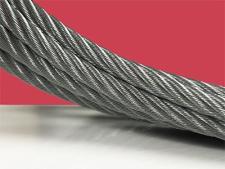The difference between mechanical cable and a mechanical cable assembly is the presence of fittings applied to the mechanical cable itself. When engineers design mechanical cable, which, depending on the cable’s diameter, can also be known as wire rope, they consider variables such as lay length, wire diameter, cable diameter, cable construction, cable coating, and a host of other factors.
But, when engineers design mechanical cable assemblies, the list of requirements grows considerably. After all, swaging fittings to stainless steel cable has its own distinct requirements, as does performing the same operation using tungsten cable, for instance.
As a matter of fact, although two different cable assemblies look the same, they cannot be treated the same because all mechanical cable assemblies are designed for an exclusive purpose and function. Applying the science that went into manufacturing stainless steel cable assemblies will not yield the same performance and functionality found in tungsten cable alternatives.
Browse Our Entire Selection of Mechanical Cable Fittings
Matching Fitting Material to Cable Material
When producing mechanical cable assemblies, among the earliest critical questions engineers ask themselves are, “will it hold a load, in a system, for a very long time?” More precisely, engineers designing mechanical cable assemblies know to the decimal point how much load the cable assembly must support, how many cycles it should achieve, and under what conditions must the assembly support the load. For example, using 302 stainless steel cable, in a saltwater environment, will yield you a cable assembly that will degrade over time due to the harsh consequences of salt on the 302 stainless steel material. Similarly, using galvanized steel cable in the same environment will result in oxidization as well, leading to rust, corrosion, and ultimately system failure.
While these are only a pair of use cases that demonstrate the unwanted consequences of the wrong cable, in the wrong environment, fittings applied to the cable must be evaluated equally too.
Using the same case scenario, 316 stainless steel cable performs exceptionally well where saltwater is present. This performance improvement, over other stainless steel cable alternatives, is attributable to the 2% to 3% of molybdenum content present in 316 stainless steel. However, as good a job as 316 stainless steel will do functioning in saltwater applications, adding 302 stainless steel fittings to an otherwise sound 316 stainless steel cable choice, will result in a mechanical cable assembly only partially suited to the system to which it is deployed.
This is why mechanical cable assembly makers advise customers, not only on cable material selection but also on the fittings required.
Breaking & Holding Strength of the Cable Assembly
Your wire rope provider is dutybound to ask mission-critical questions, such as, “to what is the cable assembly attaching itself?” Though a seemingly academic question, the query is the first in a series that determines the performance of the cable assembly in the field.
Take cases where slack is required to install the mechanical cable assembly within a system. In this instance, a threaded plug would be ideal, because thread plugs permit system operators to tighten and loosen the entire cable assembly with a few twists of the threaded fitting.
But what about the assembly’s strength is compromised by the presence of a swaged threaded plug cable fitting?
Well, nothing actually.
Threaded plugs are a perfect application for tension-required cable assemblies because threaded plugs are manufactured with sufficient material on the end, and an adequate ID to achieve the full-rated breaking strength of the mechanical cable. Because of the adequate amount of metal material making contact with the mechanical cable, the likelihood of a failure to support the rated load is extremely low. However, adding a ball fitting, conversely, to the very same mechanical cable application will result in failure, due to a lack of material on the ball fitting itself. Unlike in the case of a threaded plug cable fitting, the amount of cable material and ball fitting material making swaged contact with one another is insufficient.
In general, an inadequately held cable fitting will fail sooner than the cable itself.
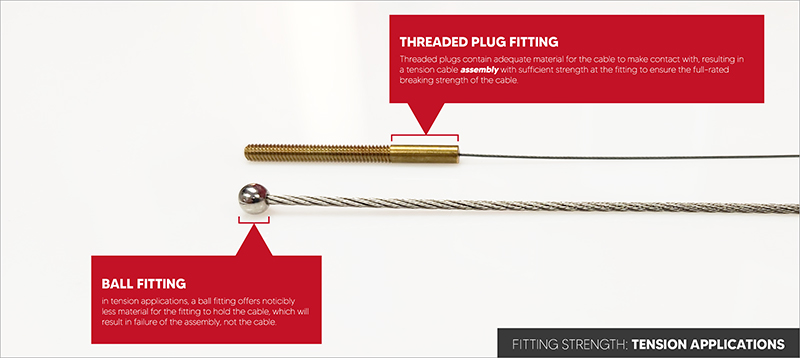

Thus, although the full-rated breaking strength of the cable may be within required standards, the cable assembly is what is being measured, and will fail to achieve its full-rated breaking strength due to the limited connectivity between the fitting and the cable – again, in this use case.
So, as compatible as perhaps a cable fitting’s dimensions are with a system, the quantity of material making contact with the cable is as critical an informer of the assembly’s success, as is cable material, fitting choice and the application environment.
Cable Construction Informs Holding Strength
To realize the cable assembly’s full-rated breaking strength, not only do engineers need to use the correct cable and cable fittings material, but they must also evaluate whether adequate contact can be made between fittings and the cable itself. Assisting in producing acceptable contact is both being made (and sustained) is a mechanical cable’s wire count, also known as cable construction.
Cable construction is the term used to describe the quantity of individual wires comprising a length of cable and their helical orientation to one another. Wire rope and mechanical cable can be produced out of as few as two wires, and here at Carl Stahl Sava Industries, wire counts climb to as high as 703 wires. When applying cable fittings to cable, the number of points of contact the cable possesses greatly informs the success with which the cable assembly achieves its full-rated breaking strength.
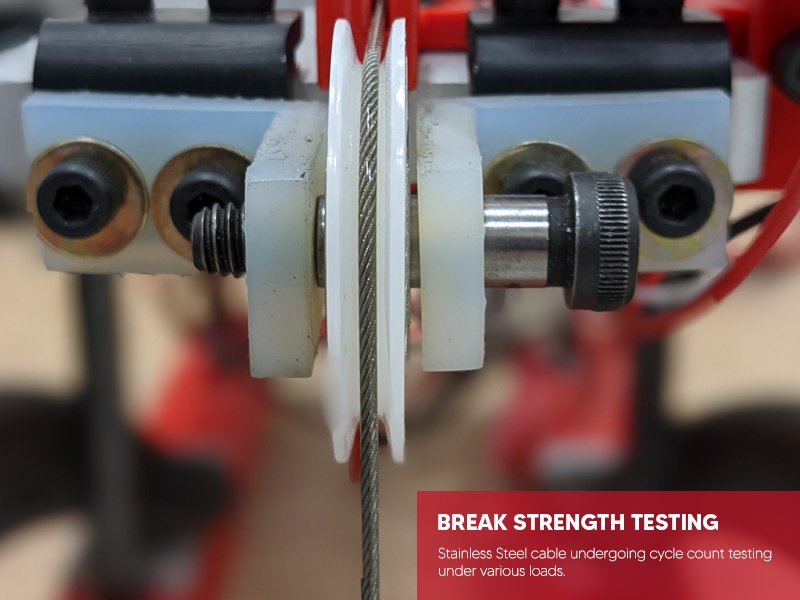

Think about holding a 10 lbs. dumbbell between your thumb and index finger, as opposed to enclosing it within your entire fist. While the two-fingered approach to supporting the 10 lbs. will work, at least for a while, do you need to hold it longer than two fingers will permit? If so, you’re likely to revise the load-bearing strategy to include your complete hand, guaranteeing more points of contact between your hand and the dumbbell, resulting in dependable and sustainable support of the load.
Analogously, a .019”, 1x7 stainless steel mechanical cable construction, without fittings applied, will achieve a breaking strength of 40 lbs. Yet, a .019”, 7x49 tungsten mechanical cable construction yields a breaking strength of 60 lbs.
The 1x7 cable includes six wires helically stranded around a center core wire, while the tungsten cable, a totally different construction, contains 343 wires, yet is identical in diameter to the 1x7. So, although these two mechanical cables are the same size, the cable with the 343 wires, again, dramatically increases the points of contact for which to swage mating cable fittings.
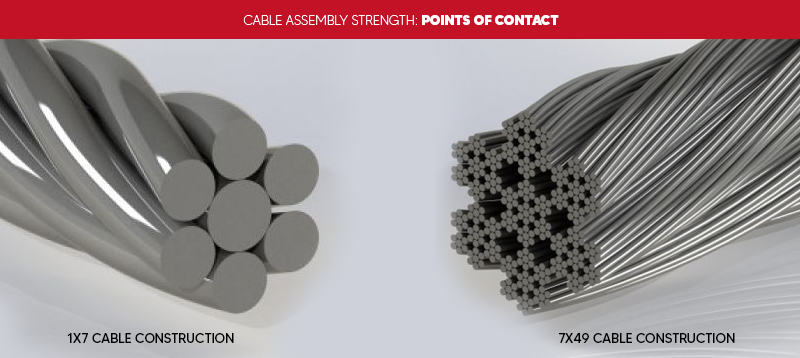

The more contact that can be made between the cable fittings and the cable’s stranded wires means mating surfaces are increased. And providing the fittings applied to the mechanical cable are both (a) made of the proper materials, (b), applied properly, and (c), possess adequate contact area to achieve acceptable hold on the cable, the cable assembly’s application requirements will be met.
Applying Cable Fittings to Coated Mechanical Cable
Coated mechanical cable, also called extruded cable, is cable wrapped in a “jacket,” that adds a layer of protection to bare cable. Extruded material can be added to virtually any cable material, but is most often applied to stainless and galvanized steel wire rope and mechanical cable. Coated cable is made from materials such as nylon (polyimide or PA), vinyl (Polyvinyl chloride or PVC), FEP (Fluorinated Ethylene Propylene or Teflon), and several others.
When applying cable fittings to coated cable, no matter the coating material, achieving the full-rated breaking strength of the coated cable is most often done by stripping a small amount of the coated material from the cable, to allow cable fittings firm, metal-to-metal contact with one another. Because the material coating the cable is malleable, applying fittings directly to coated cable surfaces means cable fittings are swaged on top of the extrusion. When this is done, the metal surface of the bare cable is not in direct contact with the cable fitting, which degrades the cable assembly’s strength. And unless the full-rated breaking strength of the cable assembly is achieved with fittings applied directly to the coated material, the coated cable will fail in the field.
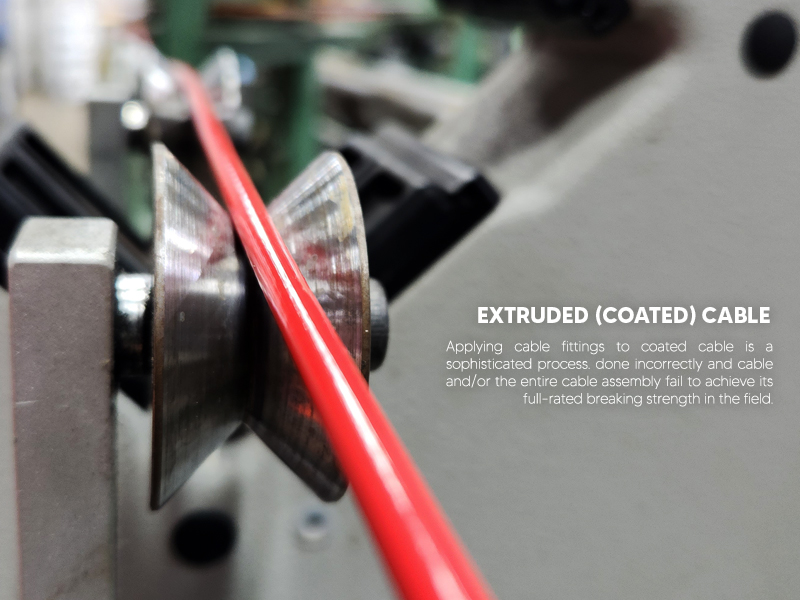

Think of it this way: if your coated mechanical cable is rated to support 10 lbs., but the system in which it is deployed requires a load no greater than 5 lbs., then swaging cable fittings directly to the coated cable will succeed. However, if the rated load of the coated cable is 10 lbs., and that is also the load the cable assembly will be under, cable fittings pressed directly to the coated material on the cable will result in failure to support the required system load.
Getting Mechanical Cable Fittings Right
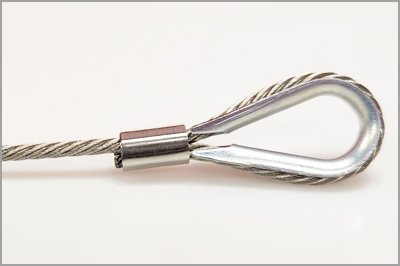

Thimbles are a type of mechanical cable fitting that inserts within the interior of a loop in a cable assembly. Typically the loop is secured with what is known as a crimp sleeve or loop sleeve. In this rather common cable assembly design example, the thimble provides a protective barrier that keeps the cable’s individual wires from coming in contact with the components attached via the loop. The shield provided by the thimble allows the mechanical cable assembly to shift, move and behave in its designed range of motion without causing unwanted or premature deformation to the cable assembly, or the mating components to which it is joined.
By way of example, the thimble addresses and mitigates the risks of metal-on-metal fatigue that, over time, will cause early cable assembly failure.
Remembering that the difference between a mechanical cable and a mechanical cable assembly is the presence of cable fittings, simply applying a crimp sleeve fitting to a length of mechanical cable constitutes a cable assembly. But, leaving the thimble fitting out of the cable assembly’s design means failure in the field, due to the constant friction that will occur between the bare cable’s loop and other components now designed to make contact with one another.
As one can plainly see, a tremendous amount of design consideration enters into planning a mechanical cable assembly. Even more, a cable assembly’s fittings can become the point of failure long before the cable’s full-rated break strength comes into consideration. It’s critical to ensure that your mechanical cable assembly design engineers consult with wire rope and cable assembly manufacturers to be absolutely certain any point of potential assembly failure is eliminated. To do this, a meticulous analysis of the cable, as well as its components, are compatible with one another, as well as the system and environment in which they are installed.
Consult Sava’s mechanical cable assembly design experts today and take advantage of our over 50 years of experience getting the world’s mechanical cable assemblies right the first time.

